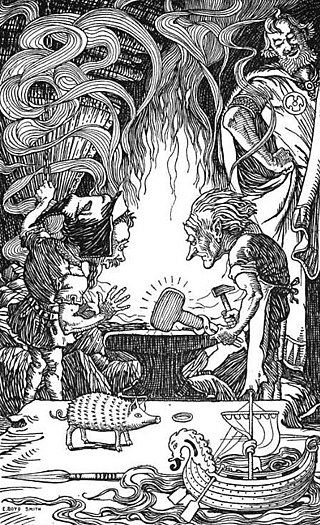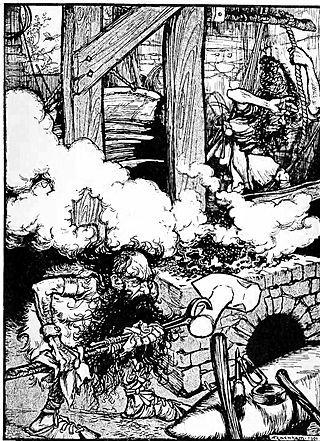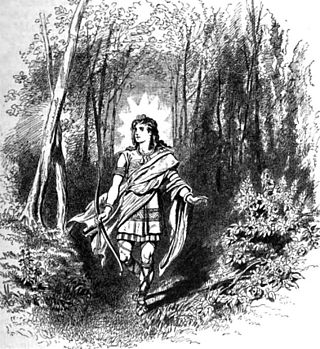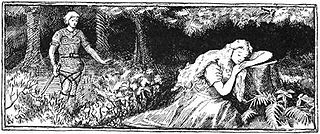
Baldr is a god in Germanic mythology. In Norse mythology, he is a son of the god Odin and the goddess Frigg, and has numerous brothers, such as Thor and Váli. In wider Germanic mythology, the god was known in Old English as Bældæġ, and in Old High German as Balder, all ultimately stemming from the Proto-Germanic theonym *Balðraz.

Loki is a god in Norse mythology. He is the son of Fárbauti and Laufey, and the brother of Helblindi and Býleistr. Loki is married to the goddess Sigyn and they have two sons, Narfi or Nari and Váli. By the jötunn Angrboða, Loki is the father of Hel, the wolf Fenrir and the world serpent Jörmungandr. In the form of a mare, Loki was impregnated by the stallion Svaðilfari and gave birth to the eight-legged horse Sleipnir.

Skíðblaðnir, sometimes anglicized as Skidbladnir or Skithblathnir, is the best of ships in Norse mythology. It is attested in the Poetic Edda, compiled in the 13th century from earlier traditional sources, and in the Prose Edda and Heimskringla, both written in the 13th century by Snorri Sturluson. All sources note that the ship is the finest of ships, and the Poetic Edda and Prose Edda attest that it is owned by the god Freyr, while the euhemerized account in Heimskringla attributes it to the magic of Odin. Both Heimskringla and the Prose Edda attribute to it the ability to be folded up—as cloth may be—into one's pocket when not needed.

Fulla or Volla is a goddess in Germanic mythology. In Norse mythology, Fulla is described as wearing a golden band and as tending to the ashen box and the footwear owned by the goddess Frigg, and, in addition, Frigg confides in Fulla her secrets. Fulla is attested in the Poetic Edda, compiled in the 13th century from earlier traditional sources; the Prose Edda, written in the 13th century by Snorri Sturluson; and in skaldic poetry. Volla (Folla) is attested in the "Horse Cure" Merseburg Incantation, recorded anonymously in the 10th century in Old High German, in which she assists in healing the wounded foal of Phol and is referred to as Frigg's sister. Scholars have proposed theories about the implications of the goddess.

In Norse mythology, Brokkr is a dwarf, and the brother of Eitri or Sindri.

In the Old Norse religion, Eitri is a dwarf and the brother of Brokkr.

Lokasenna is one of the poems of the Poetic Edda. The poem presents flyting between the gods and Loki. It is written in the ljóðaháttr metre, typical for wisdom verse. Lokasenna is believed to be a 10th-century poem.

In Norse mythology, Svaðilfari is a stallion that fathered the eight-legged horse Sleipnir with Loki. Svaðilfari was owned by the disguised and unnamed jötunn who built the walls of Asgard.

In Norse mythology, Váli or Boe or Bous (Latin) is a god and the son of the god Odin and Rindr. Váli has numerous brothers including Thor, Baldr, and Víðarr. He was born for the sole purpose of avenging Baldr, and does this by killing Höðr, who was an unwitting participant, and binding Loki with the entrails of his son Narfi. Váli grew to full adulthood within one day of his birth, and slew Höðr before going on to Loki. He is prophesied to survive Ragnarök.

Hermóðr is a figure in Norse mythology, a son of the god Odin and brother of Baldr.

Mjölnir is the hammer of the thunder god Thor in Norse mythology, used both as a devastating weapon and as a divine instrument to provide blessings. The hammer is attested in numerous sources, including the 11th century runic Kvinneby amulet, the Poetic Edda, a collection of eddic poetry compiled in the 13th century, and the Prose Edda, a collection of prose and poetry compiled in the 13th century. The hammer was commonly worn as a pendant during the Viking Age in the Scandinavian cultural sphere, and Thor and his hammer occur depicted on a variety of objects from the archaeological record. Today the symbol appears in a wide variety of media and is again worn as a pendant by various groups, including adherents of modern Heathenry.

Gullinbursti, meaning "Gold Mane" or "Golden Bristles") is a boar in Norse mythology.

In Norse mythology, Hringhorni is the name of the ship of the god Baldr, described as the "greatest of all ships".

In Norse mythology, the Sons of Ivaldi are a group of dwarfs who fashion Skíðblaðnir, the flying ship of Freyr, Gungnir, the spear belonging to Odin, as well as the golden hair for Sif to replace the hair that Loki had cut off.

Mjolnir, known more formally as Mjölnir, is a fictional magical weapon appearing in American comic books published by Marvel Comics. It is depicted as the principal weapon of the superhero Thor. Mjolnir, which first appears in Journey into Mystery #83, was created by writers Stan Lee and Larry Lieber and designed by artists Jack Kirby and Joe Sinnott.
In Norse mythology, Sindri is the name of both a dwarf and a hall that will serve as a dwelling place for the souls of the virtuous after the events of Ragnarök. Sindri is also referred to as Eitri, the brother of Brokkr.
Loki's wager is the insistence that because two or more categories exist as poles on a spectrum with a grey area in the middle, the distinction between the two cannot be defined.

Skáldskaparmál is the second part of the Prose Edda, compiled by Snorri Sturluson. It consists of a dialogue between Ægir, the divine personification of the sea, and Bragi, the god of poetry, in which both stories of the Æsir and discourse on the nature of poetry are intertwined. The work additionally includes tales of human heroes and kings. The overarching mythological setup gradually fades and the work becomes more of an early form of a poetic thesaurus of Old Norse, presumably intended for usage by skalds. Much of the work is focused on poetic phrases and descriptors. The origin of these kennings is given; Bragi delivers a systematic list of kennings for various Æsir, people, places, and things. He then goes on to discuss poetic language in some detail, in particular heiti, essentially poetic synonyms or alternate words. For example, the simple hestr, "horse", might be replaced by jór, "steed".

Norse Mythology is a 2017 book by Neil Gaiman, which retells several stories from Norse mythology. In the introduction, Gaiman describes where his fondness for the source material comes from. The book received positive reviews from critics.

Mjölnir and Stormbreaker, in the Marvel Cinematic Universe (MCU), are sentient enchanted weapons of choice used by Thor. Both are melee weapons and were created out of Uru metal forged with the heat of a dying star in the Dwarven kingdom of Nidavellir, with the assistance of the dwarf king and master weapon-maker Eitri. Mjolnir is a hammer, and was enchanted by Thor's father, Odin, so that only those the hammer deemed "worthy" are capable of wielding or even lifting it. Stormbreaker is an axe, and although it does not have such a worthiness enchantment, its power is such that a mere mortal attempting to wield it would be driven mad.
















